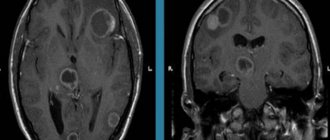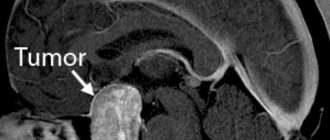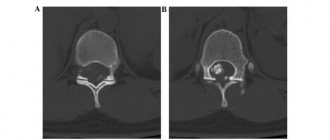Malignant neoplasms in the pituitary gland are a fairly rare phenomenon, affecting both sexes equally. Manifestations of cancerous lesions of the gland are not the same in different patients, which often significantly complicates the diagnosis of the disease. When cancerous tumors appear, hormonal imbalances do not always occur, since they are capable of secreting hormones along with healthy tissues, maintaining them at a level sufficient for the body. Oncological tumors occur in people of any age, but still more often in the working population aged 30 to 40 years.
Today's diagnostic methods make it possible to detect the disease in the early stages, if the patient promptly seeks the help of a specialist. Since the vast majority of pituitary tumors are benign, you should not panic when they are detected. Even malignant neoplasms, if detected in time, can be completely cured. Pituitary cancer develops predominantly slowly, which allows enough time for it to be detected before metastases appear.
Causes of pituitary tumors
Today, modern medicine cannot give an exact answer to the question of tumor development, but scientists have put forward some assumptions about this. In many cases, hereditary or genetic factors influence. This disease is caused by various inflammations and infections of the nervous system, injuries to the head, chronic inflammation of the paranasal sinuses (chronic sinusitis), and any other infectious diseases that are provoked by various types of bacteria and viruses. The cause of a pituitary tumor is often also the excessive influence of toxic harmful substances on the body, as well as any pathologies during pregnancy or childbirth (premature birth, infection in the amniotic fluid, cancer of the fetal membrane, etc.).
Hormonal tumors, most often pituitary tumors. With uncontrolled growth of cells that produce growth hormone, this type of disease can appear.
There is an opinion that the progression of abnormal pituitary tissues can be activated due to the unproductive activity of the peripheral glands of the endocrine system or an excess of the hormone secreted by the hypothalamus.
Treatment methods
Therapy for pituitary pathologies can be conservative or surgical. If the synthesis of pituitary hormones is reduced, hormone replacement therapy is indicated, which is usually lifelong. If there is excessive synthesis, the patient may be offered surgical treatment, or prescribed drugs that suppress the activity or production of the target hormone.
For adenoma and other neoplasms, surgical treatment is usually indicated. In addition, to relieve symptoms of the disease and suppress tumor growth, radiation therapy is used as indicated. For some types of hormone-dependent adenomas, as well as in the presence of contraindications to surgical treatment, drug therapy is used, which helps to suppress hormonal hypersecretion, and in some cases leads to a decrease in tumor size. Small hormonally inactive tumors without symptoms of compression of the optic nerves require dynamic observation without the use of surgical treatment.
Disturbances in the functioning of the pituitary gland pose a serious danger to human health and can lead to the development of a number of serious diseases. Timely diagnosis and proper treatment are the key to longevity and good health.
Symptoms of pituitary tumors
The reason for worry and contacting a specialist is for a woman a disruption in the menstrual cycle, light discharge from the nipples, and for a man - a violation of sexual growth and potency.
Symptoms of pituitary tumors can be completely different and this is due to their size. For example, neoplasms about 19 mm in size are called macroadenomas, and even smaller ones are called microadenomas. These macroadenomas tend to press against other nearby tissues.
Symptoms of neoplasms affecting surrounding tissues:
- acute headaches, frequent and sudden;
- fatigue, weakness of the body;
- deterioration or loss of vision;
- frequent constipation;
- gag reflexes, nausea;
- problems related to sexual life;
- hair loss;
- the patient gains weight or, on the contrary, loses weight.
There are pituitary tumors that produce their own hormones in addition to the pituitary gland. They are called hormonally active.
Neoplasms that produce somatotropin predetermine the occurrence of acromegaly in mature individuals, which is accompanied by the following symptoms:
- disturbance of scalp growth;
- double vision;
- discomfort in joints and muscles;
- headache;
- increase in the size of the palms and feet.
When such a disease is detected in a child, he often suffers from gigantism, abnormal development of the body structure (excessively large height, small head, elongated limbs). All this entails various pathologies on the part of sexual function, mental and physical development lags behind.
Unnatural development is determined by prolactin-secreting tumors:
- men suffer from enlargement of the parenchyma of the mammary glands (gynecomastia);
- infertility caused by the absence of menstruation in women (amenorrhea) or irregular menstrual cycles (oligomenaria);
- secretion of breast milk in men and women, which is accompanied by decreased sexual desire, fever, and sudden headaches (galactorrhea);
- men experience disruption or complete loss of sexual relationships with women.
Some adenomas that produce adrenocorticotropic hormone (ACTH) can cause excessive production of adrenal hormones, which is the source of Cushing's disease. The following symptoms are noted:
- improper distribution of adipose tissue, its placement in the face, as well as the neck, torso, but at the same time the limbs remain thin;
- the skin becomes exhausted, thin, dry and inflamed;
- acrocyanosis;
- the skin is prone to intense pigmentation, bruises and stretch marks appear;
- Diabetes mellitus or osteoporosis may occur;
- arterial hypertension;
- persistent mental defects, euphoria or depression;
- amyotrophy;
- the face becomes moon-shaped.
Thyrotropin-producing adenomas provoke the appearance of hypothyroidism. The development of the disease can begin with functional insufficiency of the thyroid gland. Gonadotropic tumors of the pituitary gland are characterized in women by frequent uterine bleeding and systemic menstrual irregularities.
The larger the tumor, the more pronounced the manifestations and symptoms of the disease can be, which will worsen in the future with the increase in tumors. If they are not corrected in time, the result can be fatal for the patient. Such adenomas cause sudden loss of vision or its deterioration, optic nerve atrophy. In the most severe cases, complete loss of vision is possible.
When adenomas affect the cranial nerves, there is a risk of damage to the nervous system. Clinical symptoms in this case are:
- sudden spasms of some parts of the body;
- nystagmus;
- severe headaches, high intracranial pressure;
- the patient's consciousness becomes impaired.
Pituitary adenoma has a very detrimental effect on the ventricles of the brain, namely, it puts pressure on them. In this case, dropsy of the brain or hydrocephalus is formed. This outcome entails disorders: paralysis of the eyeballs (ophthalmoplegia) or double vision (diplopia). The development of a harmful tumor downwards will lead to rupture of the sella turcica, as well as the spread of pathology to the sinus area, and cerebrospinal fluid leaks from the nose.
Diagnosis of pituitary tumors
At the first sign of a pituitary tumor, you should immediately contact highly qualified specialists. At the clinic, doctors will conduct examinations for hormonal and ophthalmological disorders. To do this, you will need to take a blood and urine test. This is done to determine the level of hormones.
As for the ophthalmological examination, it will help determine the size of the adenoma, as well as the direction of its formation. Next, the spinal cord fluid must be examined for the presence of proteins in it, since this may be an indirect sign of the presence of an adenoma in the brain.
The next step will be radiography, magnetic resonance imaging, computed tomography of the brain, which neurovisualizes neoplasms of the pituitary gland. But, in the case of a small tumor in size, radiography will be meaningless, since it only detects adenomas that have a clear effect on the surrounding tissue.
The exact location and volume of minor tumors are diagnosed by computer tomographs. Doctors also often use the radioimmunological method. Since, as already mentioned in the article, this disease of the pituitary gland is extremely difficult to detect, doctors use complex diagnostics to accurately determine the diagnosis.
Diagnosis of pituitary adenoma
Typically, a neurologist, ophthalmologist and endocrinologist are involved in the diagnosis of pituitary adenoma. Patients turn to the first two specialists when ophthalmic and neurological symptoms develop, and to the last one when endocrine and metabolic symptoms develop. For a more accurate diagnosis, consultation with all these doctors will be required. Standard examination for pituitary adenoma includes:
- X-ray of the sella turcica
. Shows the contour, size, shape of the pituitary gland, signs of destruction of the dorsum sella; - MRI of the brain
. Allows you to identify microscopic neoplasms in tissues and evaluate its blood circulation; - CT scan of the skull
. Reflects a more precise localization of the adenoma in the brain; - Angiography
. It is prescribed if MRI and CT did not show an adenoma, but there are signs of its presence. The study allows us to identify tumors of the smallest size; - Hormonal blood test
. The concentrations of prolactin, somatotropin, cortisol, ACTH, TSH are determined; - Ophthalmic examination
. It is necessary to check visual acuity, the condition of the fundus, and the optic nerve; - Blood chemistry
. Determines the general condition of the body. It is important to check your glucose level - its increased value indicates a metabolic disorder.
Treatment of pituitary tumors
There are several types of treatment for pituitary tumors:
- drug treatment, which is prescribed in the early stages of the disease, when doctors can do without surgery (they usually use cyproheptadine, caberglobin, bromocriptine - they regulate the level of hormones in the body);
- interstitial or external beam radiation therapy (carried out in the presence of such features in which the tumor does not allow surgical intervention);
- surgical intervention - doctors resort to this method in the most severe cases, when the disease is severely advanced or the adenoma is large. After this procedure, the patient is prescribed hormone therapy and additional radiation therapy.
Removal of adenoma by instrumental means in our time is carried out using endonasal transsphenoidal intervention, in other words, through the nasal passage. This is a completely safe method, since penetration is carried out by an endoscopic probe and miniature instruments, which avoids any infections and incisions during the operation.
Therapy
Malignant neoplasms of the pituitary gland are one of the few cancer tumors that, even at stage 3, respond well to treatment with a properly developed treatment regimen and the patient’s compliance with all recommendations.
Surgery, which is performed under general anesthesia, allows you to completely eliminate the disease in the shortest possible time. If surgery is not possible for some reason, radiation therapy using a gamma knife is used.
Recovery with timely seeking medical help occurs in 80% of cases after the first operation. In some patients, it is impossible to immediately remove all pathological cells, and then a repeat operation is indicated. Since the disease affects the endocrine gland, all surgical actions must be coordinated with an endocrinologist.
If you suspect a malignant intracranial process, it is unacceptable to postpone visiting a specialist. With this pathology, time plays a decisive role in the healing process.
Oncological diseases must be treated exclusively in specialized institutions. But you can undergo diagnostics at the clinic on Komendantsky Prospekt in St. Petersburg. Our medical center is equipped with all the necessary equipment; we work with the best laboratories in the city. The results of studies and analyzes are delivered on the day of the study or within two days, depending on the complexity of the procedure. To make an appointment for diagnostics, call us and come to the center in the Primorsky district of St. Petersburg.
Prognosis for pituitary tumors
Pituitary tumors, according to statistics, account for 15% of intracranial neoplasms. In most cases, these are benign tumors that slowly increase in size (which reduces the number of relapses); they do not extend beyond the sphenoid bone (also known as the sella turcica, where the pituitary gland is located). But there are also malignant ones, that is, those that have a cancerous nature of development.
Scientists have found that the age at which this type of disease is most often diagnosed in women and men is 30-40 years. Children very rarely suffer from this disease.
In 80% of cases, asymptomatic development of the disease is observed. It is possible to rehabilitate visual processes only at the initial stages of the development of abnormal processes.
It is difficult to make a prognosis for this disease, since it directly depends on timely recognition and initiation of treatment. Therefore, it is worth consulting a doctor promptly and undergoing routine medical examinations on time. But it is worth saying that in 25% of cases, patients with somatotropinomas and prolactinomas have a successful outcome of the disease, while the remaining adenomas are successfully cured in 80% of cases.
Prognosis and prevention
Pituitary adenoma is a benign brain tumor. However, as its size increases, it can take a malignant course: it begins to compress nearby brain tissue and its anatomical formations. Typically, after surgery, the patient’s hormonal levels are restored, and he gets rid of the symptoms of the disease. For adenomas whose diameter is more than 2 centimeters, there is a possibility of relapse. They usually occur within 5 years after the intervention.
The prognosis for pituitary adenoma depends on its type. With microcorticotropinomas, about 85% of patients completely restore endocrine functions. With prolactinomas and somatotropinomas, the probability of recovery is lower - about 20%. Such neoplasms require constant use of corrective medications.
There is no primary prevention for pituitary adenoma. Doctors have still not been able to determine the exact mechanism of development of the pathology. Secondary prevention consists of early diagnosis of the disease, regular blood donation for hormonal testing, and maintaining a healthy lifestyle. Every effort must be made to prevent head injury. If you suspect you have a pituitary adenoma or want to cure an existing disease, contact the Medscan medical center. Experienced doctors will be able to help you with this.










